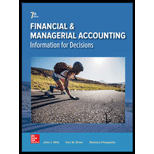
Concept explainers
a.
To compute: The value of equity.
a.
Explanation of Solution
Given,
The value of asset of A Company is $300,000 in the beginning of year
During the year asset increase $80,000.
The value of equity of A Company is $100,000 in the beginning of year.
The increase in liability of A Company is $50,000 during the year.
The formula to calculate equity is,
Substitute $380,000 for assets and $250,000 for liabilities,
Hence, the equity of A Company is $130,000.
Working Notes:
Calculation of change in equity due to increase in assets and liability
Calculation of asset at the end of the year:
Calculation of liabilities in the beginning of the year:
Calculation of liabilities at the end of the year is:
b.
To compute: The value of equity.
b.
Explanation of Solution
Given,
The value of asset of O is $123,000.
The value of liabilities of O is $47,000
The formula to calculate equity is,
Substitute $123,000 for assets and $47,000 for liabilities.
Hence, the equity of O is $130,000.
c.
To compute: Beginning and ending amount of equity
c.
Explanation of Solution
Given,
The value of liability of Q Company is $70,000 in the beginning of year,
During the year liability decrease $5,000.
The value of asset of Q Company is $190,000 at the end of year
Increase of $60,000 during the year.
The formula to calculate equity is,
Beginning equity
Substitute $130,000 for assets in the beginning of year and $70,000 for liabilities in the beginning of year,
Ending equity
Substitute $190,000 for asset at the end and $65,000 for liabilities at the end in the above equation,
Hence, the value of equity of the Q Company in the beginning of the year is $60,000 and at the end is $125,000
Working Notes:
Calculate value of asset in the beginning of year:
Calculation of change in equity due to increase in assets and liability
Calculation of Value of liabilities at the end is:
Want to see more full solutions like this?
Chapter 1 Solutions
GEN COMBO LOOSELEAF FINANCIAL AND MANAGERIAL ACCOUNTING; CONNECT ACCESS CARD
- If total debits exceed total credits on a trial balance, the difference is most likely:A. A net lossB. A recording errorC. A net incomeD. An overstatement of assetsarrow_forwardWhich of the following accounts would be found on the post-closing trial balance?A. Service RevenueB. Salaries ExpenseC. Retained EarningsD. Dividendsarrow_forwardNeed answer What type of account is Service Revenue?A. AssetB. LiabilityC. EquityD. Revenuearrow_forward
- No chatgpt What type of account is Service Revenue?A. AssetB. LiabilityC. EquityD. Revenuearrow_forwardWhat type of account is Service Revenue?A. AssetB. LiabilityC. EquityD. Revenueneed helparrow_forwardno ai What type of account is Service Revenue?A. AssetB. LiabilityC. EquityD. Revenuearrow_forward
- What type of account is Service Revenue?A. AssetB. LiabilityC. EquityD. Revenuearrow_forwardNo chatgpt Which of the following would be found in the investing activities section of the cash flow statement?A. Cash received from issuing sharesB. Cash paid for dividendsC. Cash paid for new equipmentD. Cash received from customersarrow_forwardWhich of the following would be found in the investing activities section of the cash flow statement?A. Cash received from issuing sharesB. Cash paid for dividendsC. Cash paid for new equipmentD. Cash received from customersno aiarrow_forward
- Which of the following would be found in the investing activities section of the cash flow statement?A. Cash received from issuing sharesB. Cash paid for dividendsC. Cash paid for new equipmentD. Cash received from customerhelo mearrow_forwardHelp Which of the following would be found in the investing activities section of the cash flow statement?A. Cash received from issuing sharesB. Cash paid for dividendsC. Cash paid for new equipmentD. Cash received from customersarrow_forwardWhich of the following would be found in the investing activities section of the cash flow statement?A. Cash received from issuing sharesB. Cash paid for dividendsC. Cash paid for new equipmentD. Cash received from customersarrow_forward

 AccountingAccountingISBN:9781337272094Author:WARREN, Carl S., Reeve, James M., Duchac, Jonathan E.Publisher:Cengage Learning,
AccountingAccountingISBN:9781337272094Author:WARREN, Carl S., Reeve, James M., Duchac, Jonathan E.Publisher:Cengage Learning, Accounting Information SystemsAccountingISBN:9781337619202Author:Hall, James A.Publisher:Cengage Learning,
Accounting Information SystemsAccountingISBN:9781337619202Author:Hall, James A.Publisher:Cengage Learning, Horngren's Cost Accounting: A Managerial Emphasis...AccountingISBN:9780134475585Author:Srikant M. Datar, Madhav V. RajanPublisher:PEARSON
Horngren's Cost Accounting: A Managerial Emphasis...AccountingISBN:9780134475585Author:Srikant M. Datar, Madhav V. RajanPublisher:PEARSON Intermediate AccountingAccountingISBN:9781259722660Author:J. David Spiceland, Mark W. Nelson, Wayne M ThomasPublisher:McGraw-Hill Education
Intermediate AccountingAccountingISBN:9781259722660Author:J. David Spiceland, Mark W. Nelson, Wayne M ThomasPublisher:McGraw-Hill Education Financial and Managerial AccountingAccountingISBN:9781259726705Author:John J Wild, Ken W. Shaw, Barbara Chiappetta Fundamental Accounting PrinciplesPublisher:McGraw-Hill Education
Financial and Managerial AccountingAccountingISBN:9781259726705Author:John J Wild, Ken W. Shaw, Barbara Chiappetta Fundamental Accounting PrinciplesPublisher:McGraw-Hill Education





